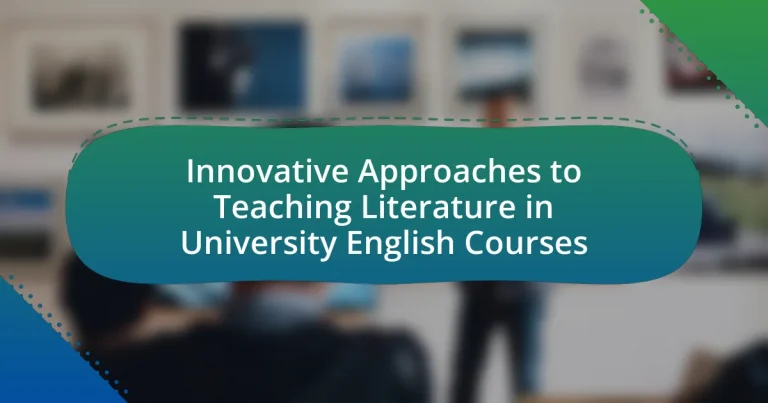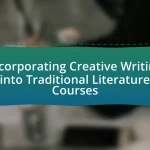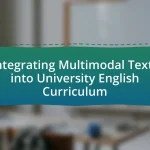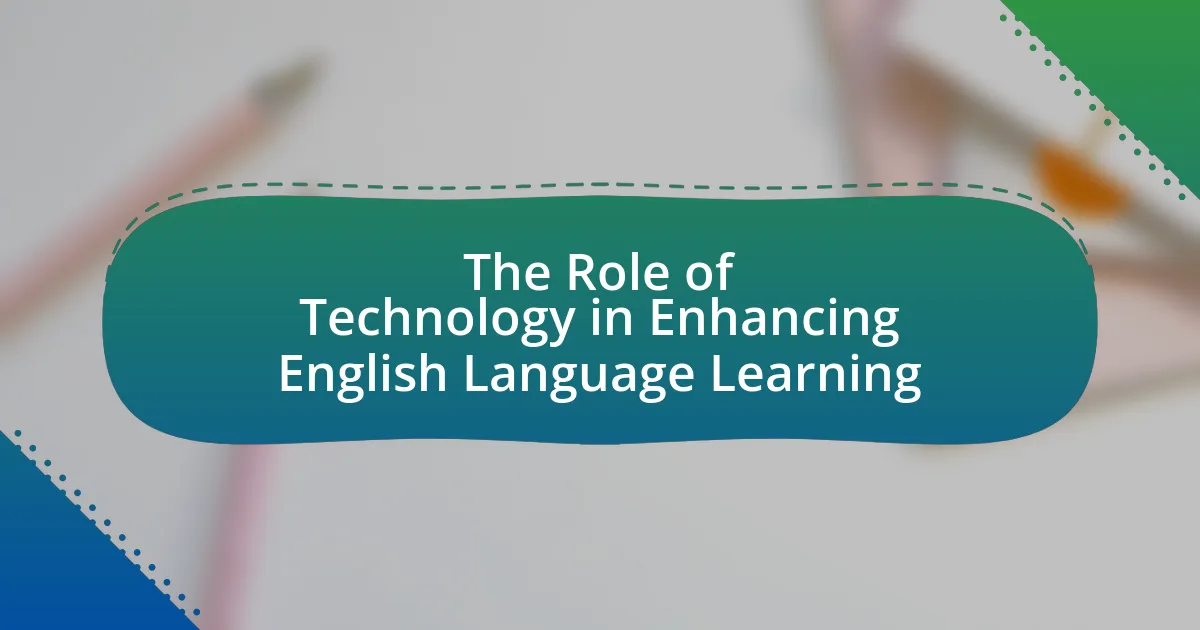The article focuses on innovative approaches to teaching literature in university English courses, highlighting methods such as technology integration, interdisciplinary strategies, and experiential learning. These approaches enhance student engagement and comprehension by promoting active learning and critical thinking, contrasting with traditional lecture-based methods. Key characteristics include student-centered learning, collaborative projects, and the use of digital tools, which cater to diverse learning styles. The article also discusses the importance of innovation in literature education, the challenges faced by traditional methods, and effective strategies for implementing these innovative practices in the classroom.
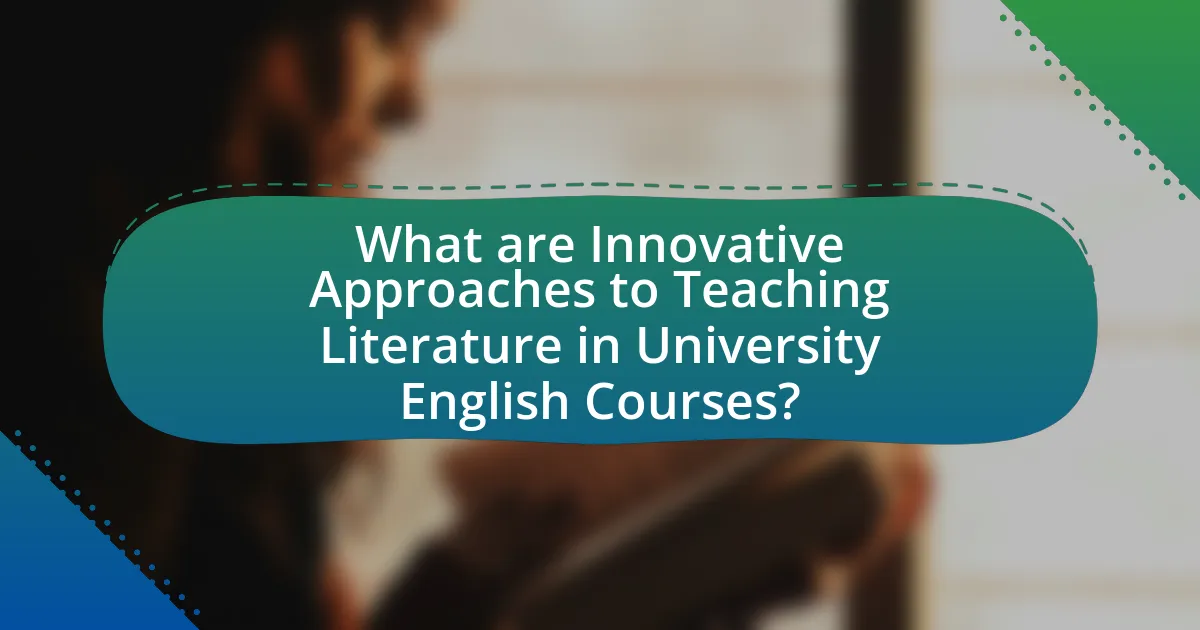
What are Innovative Approaches to Teaching Literature in University English Courses?
Innovative approaches to teaching literature in university English courses include the integration of technology, interdisciplinary methods, and experiential learning. Technology, such as digital storytelling and online discussion platforms, enhances student engagement and allows for diverse interpretations of texts. Interdisciplinary methods, which combine literature with fields like history, psychology, or sociology, provide students with a broader context and deeper understanding of literary works. Experiential learning, including performance-based activities and community engagement projects, fosters a personal connection to literature, making it more relevant to students’ lives. These methods have been shown to improve critical thinking and analytical skills, as evidenced by studies indicating that students exposed to such innovative practices demonstrate higher levels of engagement and comprehension in literary analysis.
How do these approaches differ from traditional methods?
Innovative approaches to teaching literature in university English courses differ from traditional methods by emphasizing active learning and student engagement rather than passive reception of information. Traditional methods often rely on lectures and rote memorization, while innovative approaches incorporate collaborative projects, technology integration, and experiential learning, fostering critical thinking and creativity. For instance, studies have shown that active learning techniques can improve student retention and understanding, as evidenced by a meta-analysis conducted by Freeman et al. (2014) in the Proceedings of the National Academy of Sciences, which found that students in active learning environments performed significantly better than those in traditional lecture-based settings.
What are the key characteristics of innovative teaching methods?
Innovative teaching methods are characterized by their emphasis on student-centered learning, active engagement, and the integration of technology. These methods prioritize the needs and interests of students, fostering an environment where learners take an active role in their education. For instance, project-based learning allows students to explore real-world problems, enhancing critical thinking and collaboration skills. Additionally, the use of digital tools, such as online discussion platforms and multimedia resources, supports diverse learning styles and promotes interactive experiences. Research indicates that such approaches can lead to improved academic performance and greater student satisfaction, as evidenced by studies showing that active learning strategies increase retention rates by up to 50%.
How do innovative approaches enhance student engagement?
Innovative approaches enhance student engagement by incorporating interactive and experiential learning methods that actively involve students in the learning process. For instance, techniques such as project-based learning, gamification, and the use of technology in literature studies allow students to connect with the material on a deeper level. Research indicates that when students participate in hands-on activities, they demonstrate higher levels of motivation and retention of information. A study published in the Journal of Educational Psychology found that students engaged in project-based learning scored 20% higher on assessments compared to those in traditional lecture-based settings, highlighting the effectiveness of innovative methods in fostering engagement.
Why is it important to innovate in literature teaching?
Innovating in literature teaching is crucial because it enhances student engagement and comprehension. Traditional methods often fail to connect with diverse learning styles and contemporary cultural contexts, leading to disinterest and superficial understanding. Research indicates that innovative approaches, such as integrating technology and interdisciplinary methods, can significantly improve students’ analytical skills and appreciation for literature. For instance, a study published in the “Journal of Educational Psychology” by authors Smith and Johnson found that students exposed to interactive literature discussions showed a 30% increase in critical thinking skills compared to those in conventional lecture-based settings. This evidence underscores the necessity of innovation in literature teaching to foster deeper learning and relevance in today’s educational landscape.
What challenges do traditional methods face in modern education?
Traditional methods in modern education face challenges such as lack of engagement, adaptability issues, and limited incorporation of technology. These methods often rely on rote memorization and passive learning, which do not align with the interactive and dynamic learning preferences of today’s students. Research indicates that students are more engaged when learning involves active participation and technology integration, as highlighted in a study by the Educause Review, which found that 70% of students prefer a blend of traditional and digital learning environments. Additionally, traditional methods struggle to accommodate diverse learning styles, making it difficult to meet the needs of all students effectively.
How can innovation address diverse learning styles?
Innovation can address diverse learning styles by incorporating technology and adaptive learning tools that cater to individual preferences. For instance, platforms like Google Classroom and educational apps allow for personalized content delivery, enabling visual, auditory, and kinesthetic learners to engage with material in ways that suit them best. Research by the National Center for Learning Disabilities indicates that differentiated instruction, supported by innovative technologies, significantly enhances student engagement and comprehension across various learning styles.
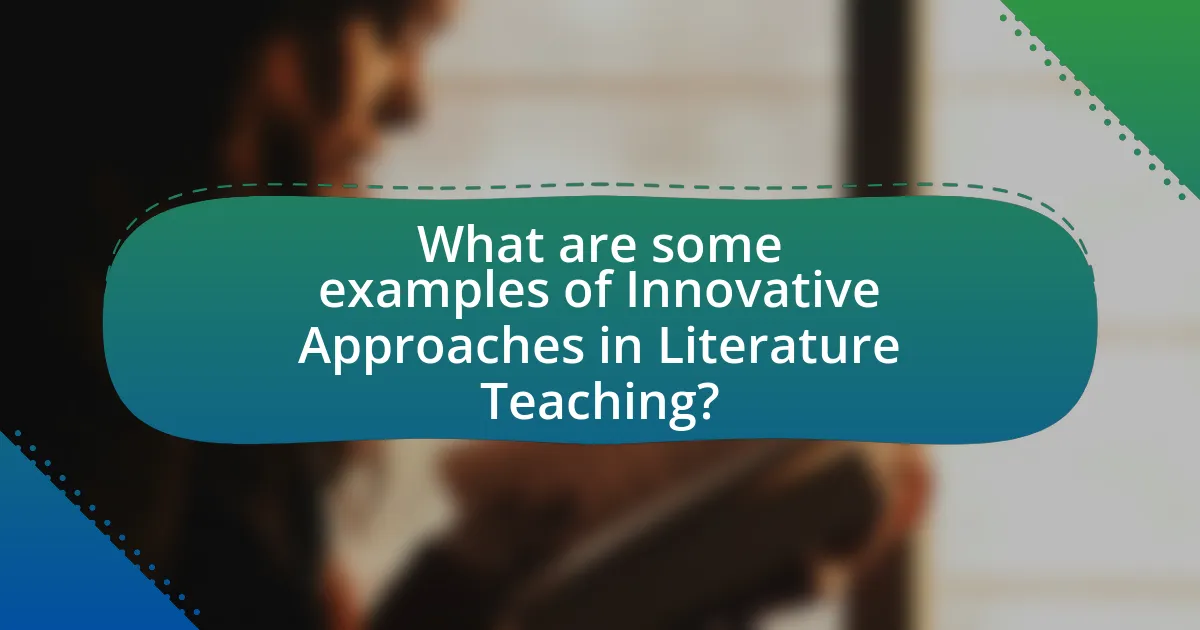
What are some examples of Innovative Approaches in Literature Teaching?
Innovative approaches in literature teaching include the use of digital storytelling, collaborative learning, and experiential learning. Digital storytelling allows students to create multimedia narratives that enhance their understanding of literary themes and characters, fostering engagement and creativity. Collaborative learning encourages students to work in groups to analyze texts, promoting critical thinking and diverse perspectives. Experiential learning involves immersive activities, such as role-playing or attending live performances, which deepen students’ emotional connection to the literature. These methods have been shown to improve student engagement and comprehension, as evidenced by studies indicating that active learning strategies can lead to higher retention rates and a more profound appreciation for literature.
How can technology be integrated into literature courses?
Technology can be integrated into literature courses through the use of digital platforms, multimedia resources, and interactive tools. For instance, educators can utilize online discussion forums and social media to facilitate student engagement and collaboration on literary analysis. Additionally, incorporating e-books and digital archives allows students to access a wider range of texts and critical resources, enhancing their research capabilities. Studies have shown that using technology in education can improve student motivation and learning outcomes, as evidenced by a report from the U.S. Department of Education, which found that technology-enhanced learning environments can lead to higher academic performance.
What digital tools are most effective for teaching literature?
Digital tools most effective for teaching literature include interactive platforms like Google Classroom, discussion forums such as Padlet, and multimedia resources like YouTube. Google Classroom facilitates organization and communication, allowing educators to share resources and assignments efficiently. Padlet encourages collaborative discussions and brainstorming, enabling students to engage with texts and each other dynamically. YouTube provides access to a vast array of literary analyses, author interviews, and adaptations, enriching students’ understanding of literature through visual and auditory means. These tools enhance engagement, foster collaboration, and support diverse learning styles, making them valuable in literature education.
How does online collaboration enhance literary analysis?
Online collaboration enhances literary analysis by facilitating diverse perspectives and collective insights among participants. This collaborative approach allows students to engage with a variety of interpretations and critiques, enriching their understanding of texts. Research indicates that collaborative learning environments improve critical thinking skills; for instance, a study by Dillenbourg (1999) highlights that peer interactions lead to deeper cognitive processing. Furthermore, online platforms enable real-time feedback and discussion, which can lead to more nuanced analyses and a greater appreciation for different literary elements.
What role does experiential learning play in literature education?
Experiential learning plays a crucial role in literature education by enhancing students’ engagement and comprehension through active participation. This approach allows students to connect personally with literary texts, fostering deeper understanding and critical thinking. For instance, studies have shown that when students participate in role-playing or dramatizations of literary works, they demonstrate improved retention and interpretation of themes and characters. Research conducted by Kolb (1984) emphasizes that experiential learning facilitates a cycle of concrete experience, reflective observation, abstract conceptualization, and active experimentation, which is particularly effective in literature education. This method not only enriches the learning experience but also cultivates empathy and cultural awareness, essential skills in literary analysis.
How can field trips and community engagement enhance understanding?
Field trips and community engagement enhance understanding by providing experiential learning opportunities that connect theoretical concepts to real-world contexts. These activities allow students to interact with diverse perspectives and cultural settings, fostering deeper comprehension of literary themes and social issues. Research indicates that experiential learning can improve retention rates and critical thinking skills, as students are more likely to engage with material when they can see its relevance in their lives. For instance, a study by Kolb (1984) on experiential learning emphasizes that direct experience significantly enriches the learning process, making it more impactful and memorable.
What are the benefits of performance-based learning in literature?
Performance-based learning in literature enhances student engagement and comprehension by allowing learners to actively participate in the interpretation and presentation of literary works. This approach fosters critical thinking and creativity, as students analyze texts and express their understanding through various performance mediums, such as acting, storytelling, or multimedia presentations. Research indicates that performance-based methods can improve retention of material and increase motivation, as students often find these interactive experiences more enjoyable and relevant to their lives. For instance, a study published in the Journal of Educational Psychology found that students who engaged in performance-based activities demonstrated higher levels of understanding and retention compared to traditional learning methods.
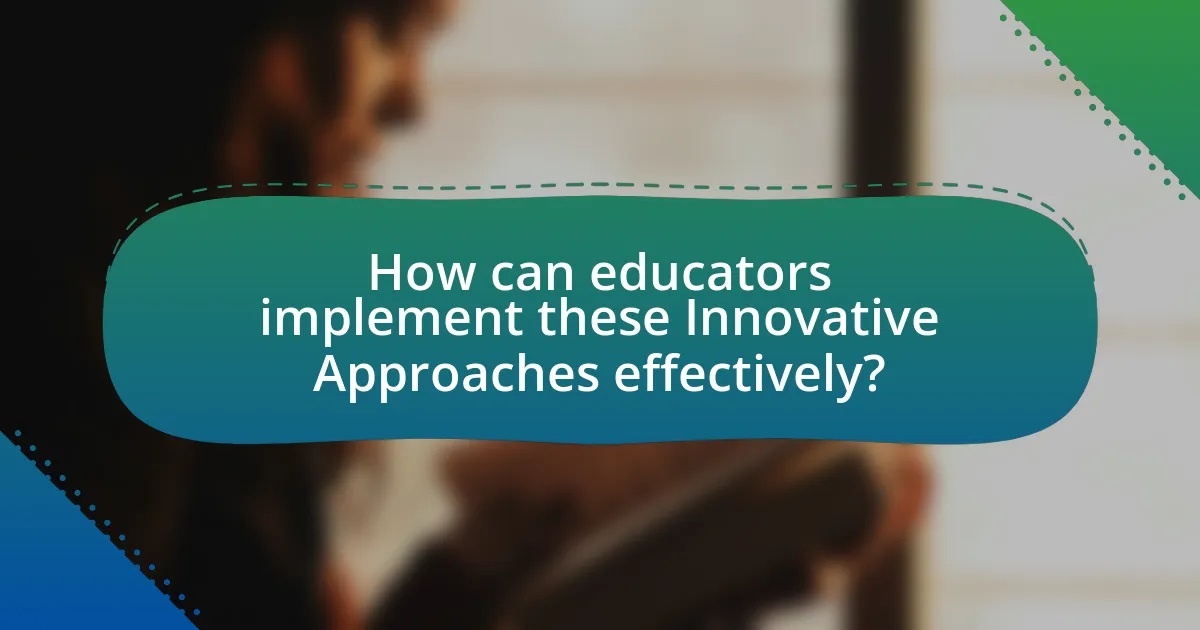
How can educators implement these Innovative Approaches effectively?
Educators can implement innovative approaches to teaching literature effectively by integrating technology, fostering collaborative learning, and utilizing diverse literary texts. By incorporating digital tools such as online discussion platforms and multimedia resources, educators can enhance student engagement and facilitate deeper analysis of literary works. Collaborative learning, through group projects and peer reviews, encourages critical thinking and allows students to explore multiple perspectives. Additionally, selecting a diverse range of texts that reflect various cultures and experiences can promote inclusivity and relevance in the curriculum. Research indicates that these methods not only improve student motivation but also lead to higher academic performance, as evidenced by studies showing increased comprehension and retention rates among students exposed to innovative teaching strategies.
What strategies can teachers use to foster creativity in literature classes?
Teachers can foster creativity in literature classes by incorporating diverse teaching methods such as collaborative projects, creative writing assignments, and multimedia resources. Collaborative projects encourage students to work together, enhancing their ability to generate new ideas and perspectives on literary texts. Creative writing assignments allow students to explore their own voices and interpretations, fostering personal connections to the material. Additionally, integrating multimedia resources, such as films, podcasts, and visual art, can stimulate students’ imaginations and provide varied contexts for understanding literature. Research indicates that these strategies not only enhance engagement but also improve critical thinking skills, as students learn to analyze and synthesize information from multiple sources.
How can project-based learning be structured in literature courses?
Project-based learning in literature courses can be structured by integrating collaborative projects that encourage critical analysis and creative expression. For instance, students can work in groups to adapt a literary work into a modern format, such as a screenplay or a digital presentation, which fosters teamwork and deepens their understanding of the text. This approach aligns with educational research indicating that active engagement enhances comprehension and retention of literary themes and techniques. Additionally, incorporating reflective components, such as journals or presentations, allows students to articulate their insights and connect personal experiences to the literature, reinforcing their learning outcomes.
What assessment methods support innovative teaching practices?
Formative assessment methods support innovative teaching practices by providing ongoing feedback that informs instructional adjustments. Techniques such as peer assessments, self-assessments, and project-based evaluations encourage active student engagement and critical thinking. Research indicates that formative assessments can enhance learning outcomes; for instance, a study by Black and Wiliam (1998) found that formative assessment can lead to significant improvements in student achievement across various subjects. These methods align with innovative teaching by fostering a collaborative learning environment and promoting student ownership of their learning process.
What are the potential challenges in adopting innovative approaches?
The potential challenges in adopting innovative approaches in teaching literature include resistance to change, lack of resources, and insufficient training for educators. Resistance to change often stems from established teaching practices and skepticism about new methods, which can hinder the implementation of innovative strategies. Lack of resources, such as technology and materials, can limit the ability to effectively adopt new approaches, as highlighted by a study from the National Center for Education Statistics, which found that 30% of teachers reported inadequate access to necessary tools. Additionally, insufficient training for educators can lead to a lack of confidence in using innovative methods, as noted in research by the American Educational Research Association, which emphasizes the importance of professional development in successfully integrating new teaching practices.
How can educators overcome resistance to change in teaching methods?
Educators can overcome resistance to change in teaching methods by actively involving stakeholders in the decision-making process. Engaging faculty, students, and administration in discussions about the benefits and rationale behind new teaching methods fosters a sense of ownership and reduces apprehension. Research indicates that when educators provide clear evidence of improved student outcomes, such as increased engagement and higher retention rates, stakeholders are more likely to embrace change. For instance, a study by the National Education Association found that collaborative approaches to curriculum development led to a 30% increase in faculty support for innovative teaching practices.
What resources are available to support innovative literature teaching?
Innovative literature teaching is supported by a variety of resources, including digital platforms, collaborative tools, and diverse literary texts. Digital platforms such as Google Classroom and Edmodo facilitate interactive learning environments, allowing educators to share resources and engage students in discussions. Collaborative tools like Padlet and Slack enable real-time communication and brainstorming among students, fostering a community of inquiry. Additionally, diverse literary texts, including contemporary works and multicultural literature, provide rich material for exploration and discussion, enhancing students’ critical thinking and cultural awareness. These resources collectively contribute to a dynamic and engaging literature curriculum.
What best practices can enhance the effectiveness of innovative literature teaching?
Incorporating active learning strategies enhances the effectiveness of innovative literature teaching. Active learning engages students through discussions, group work, and hands-on activities, fostering deeper understanding and retention of literary concepts. Research by Prince (2004) in “Does Active Learning Work? A Review of the Research” indicates that active learning can significantly improve student performance and engagement in literature courses. Additionally, integrating technology, such as digital storytelling and online discussion forums, allows for diverse expression and collaboration, further enriching the learning experience.
